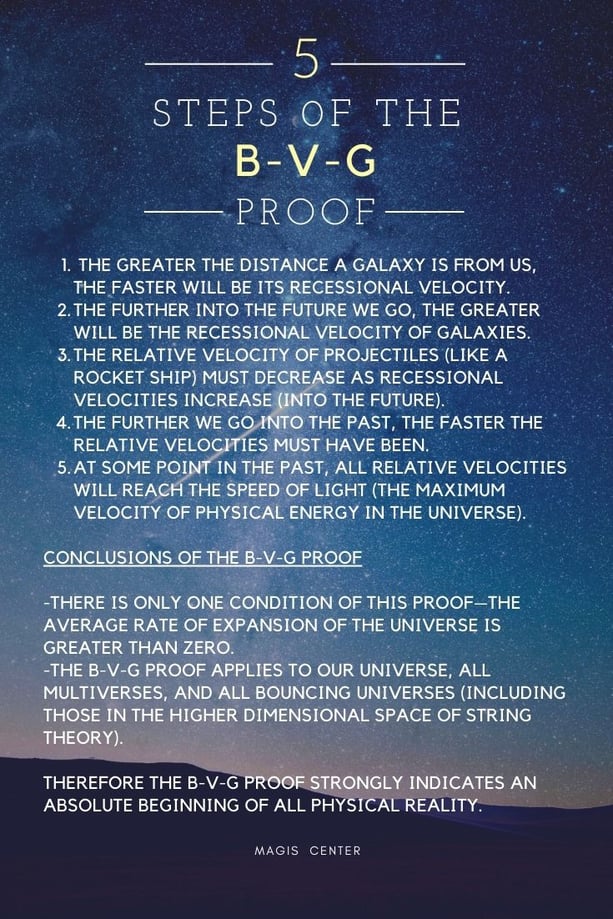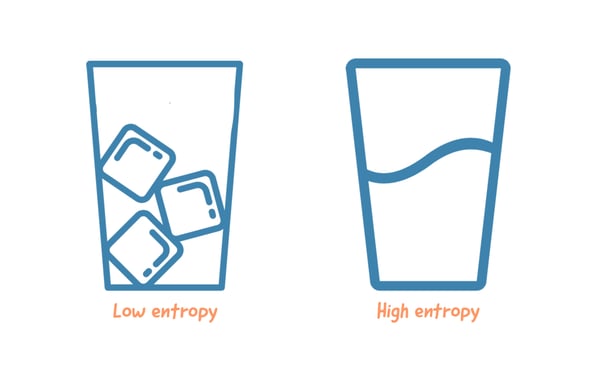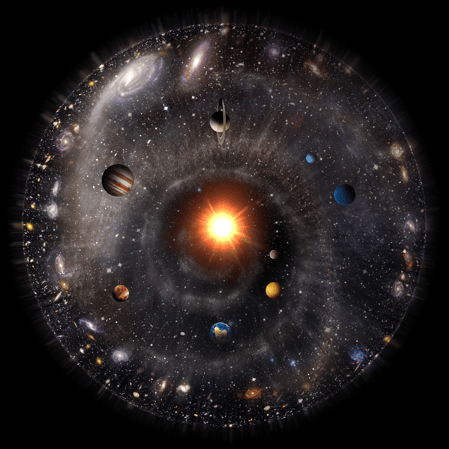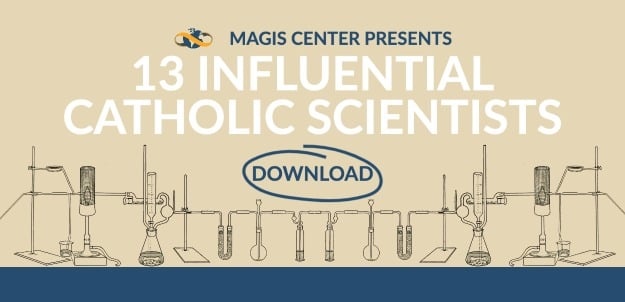In 1927, Monsignor Georges Lemaître, a Catholic priest, noted cosmologist, and colleague of Einstein’s, postulated what would later come to be known as the Big Bang theory. Lemaitre theorized that galaxies were not moving in fixed Euclidean space but rather that the space between the galaxies was stretching and growing (which might be analogized by a balloon being inflated).
Today, there is only a finite distance between galaxies, so we know that the universe could not have been expanding forever in the past. All of the points must have been arbitrarily close to one another at some time in the finite past. If the Big Bang marks the initial expansion of the universe, then could it be the beginning of the universe?
 Big Bang-Inflation / Alex Mittelmann, coldcreation, via Wikimedia Commons
Big Bang-Inflation / Alex Mittelmann, coldcreation, via Wikimedia Commons
Fr. Lemaître’s hypothesis of the expansion of our universe, which was confirmed by observations made by the astronomer Edwin Hubble in 1929, enabled other physicists to formulate theorems (proofs) about the necessity of a beginning. The most recent one is called the Borde-Vilenkin-Guth proof (or the BVG proof).
In this post, we’ll discuss the BVG proof and entropy as physical and scientific evidence for the beginning of physical reality. We’ll then look at the ancient philosophical dictum, “nothing comes from nothing.”
Evidence for the Beginning of the Universe from the Borde-Vilenkin-Guth Proof
In 2003, three scientists by the name of Borde, Vilenkin, and Guth formulated an elegant proof of a boundary to past time in all cosmologies where the average Hubble expansion is greater than zero.
How Does the Major Premise of the BVG Theorem Work?

While one could write pages on the BVG Theorem, here, we will summarize it in 5 points:
- All relative velocities of objects in intergalactic space will slow down into the future; therefore, they must have been going faster in the past.
- At some finite time in the past, relative velocities would have reached the speed of light, and this would have marked a beginning of time and of the universe as we know it.
- If a velocity higher than the speed of light is discovered in our universe, the proof would not be undermined. This is so because it does not matter what the highest velocity is, but only that there must be a maximum velocity (whatever it may be).
- There must always be a maximum possible velocity in any universe or multiverse. If there were no physical energy, it could travel at an infinite velocity, meaning that it would be everywhere at the same time. This creates a problem of multiple manifestations of energy and a series of intrinsic contradictions.
- Therefore, there must be a beginning of every universe or multiverse that has an average rate of expansion greater than zero.
BVG Theorem: A Universally Applicable Proof
The BGV proof is virtually universally applicable and very difficult to disprove (because it has only one condition). It even applies to eternal inflation, where the universe's expansion lasts forever throughout most of the universe. Vilenkin states it as follows:
“We made no assumptions about the material content of the universe. We did not even assume that gravity is described by Einstein’s equations. So, if Einstein’s gravity requires some modification, our conclusion will still hold. The only assumption that we made was that the expansion rate of the universe never gets below some nonzero value, no matter how small. This assumption should certainly be satisfied in the inflating false vacuum. The conclusion is that past-eternal inflation without a beginning is impossible.” —Alexander Vilenkin
We should not underestimate the implications of Vilenkin’s statement. He is claiming that the proof is valid almost independently of the physics of any universe (except for the one condition that the average expansion rate of the universe or multiverse is greater than zero). He is further claiming that such a universe without a beginning is impossible!
At this point, it seems as if physics is coming very close to proving an absolute beginning of physical reality itself. If no physically realistic exception can be found to this proof (and to the problems of an eternally static universe), it would make an absolute beginning of physical reality quite probable.
This takes us to the threshold of metaphysics. Before moving in that direction, let’s first consider another vastly applicable datum that also indicates the likelihood of the beginning of physical reality: that of entropy.
Evidence for the Beginning of the Universe from Entropy
Entropy is a technical concept that measures the amount of thermal energy in a system available to do work, but it can also be used to describe the “disorder” or disorganization of a system.
Entropy can be explained as follows: work requires a change of one form of energy into another. In a physical system, the available amount of energy decreases when work is done. Because energy is released by changes in molecular order (think of wood burning, ice melting, or even water boiling), ordered molecular arrangements lose some of their order and become "disordered." This measure of disorder (or loss of energy available to do work) is known as entropy.
 To make a system more organized requires external input of some kind of energy. Our solar system is a good example of an open system. Earth, for example, receives energy from the sun, powering its chemical and biological activity. The universe, on the other hand, is an isolated system.
To make a system more organized requires external input of some kind of energy. Our solar system is a good example of an open system. Earth, for example, receives energy from the sun, powering its chemical and biological activity. The universe, on the other hand, is an isolated system.
 Artist's logarithmic scale conception of the local region of the universe with the Solar System at the center, inner and outer planets, Kuiper belt, Oort cloud, Alpha Centauri, Perseus Arm, Milky Way galaxy, Andromeda galaxy, nearby galaxies. / Pablo Carlos Budassi via Wikimedia Commons
Artist's logarithmic scale conception of the local region of the universe with the Solar System at the center, inner and outer planets, Kuiper belt, Oort cloud, Alpha Centauri, Perseus Arm, Milky Way galaxy, Andromeda galaxy, nearby galaxies. / Pablo Carlos Budassi via Wikimedia Commons
The famous Second Law of Thermodynamics says that, in isolated systems, entropy always increases or stays the same and never decreases. That is why some processes are irreversible. If a process changes the entropy, then it can only go one way: the way that entropy (disorganization) increases. That is why dead bodies decompose, but do not recompose!
Of course, these are, ultimately, probabilistic statements. Entropy can have random fluctuations downward, but these are usually very tiny decreases, and the larger the decrease in entropy, the more unlikely it is to happen.
So, Can Entropy Prove that the Universe Had a Beginning?
Entropy is a universal phenomenon and is relevant to the question of whether the universe had a beginning.
If the universe had not had a beginning, it would have been around for an infinite time. In a sense, the universe would then be a “perpetual motion machine,” a system that never “runs down” or “wears out,” violating the Second Law of Thermodynamics.
The argument against an infinite universe can be broken down into five steps:
- For a physical system to do work, it needs to have order within it. It also needs differences (disequilibrium)—for example, temperature or pressure or molecular distribution—for it to do work.
- Once the physical system does work, it loses a small amount of its order. As a result, it is not capable of doing as much work as it could in its previous state. (Think again of a campfire burning or of ice melting.)This movement from order to disorder is called “entropy.”
- For statistical reasons alone, entropy (the movement from order to disorder) is irreversible in the long term (though there may be random fluctuations toward lower entropy that do not and cannot last long).
- If the universe is an isolated physical system (the assumption of the standard Big Bang model), then the universe could not have existed for an infinite amount of time because if it had, then today, it would be at a state of maximum entropy (and would have reached maximum equilibrium for the reasons stated in 1-3 above). It would be a dead universe incapable of any work.
- But the universe is not at maximum entropy (maximum equilibrium); there are hot stars, and cold space, galactic clusters, empty space, and physical systems are continuously working—stars burning, planets forming, and physicists thinking about it.
Therefore, the universe has not existed for an infinite amount of time (and therefore has a beginning). The fact that our universe must have had low entropy at its beginning is one of the arguments for a finely tuned universe.
Discussion of Something, Nothing, and Creation
The discussion in the two foregoing sections shows that the preponderance of cosmological evidence favors a beginning of the universe where, prior to which, there was no physical reality. Is this evidence sufficient to show the beginning of physical reality itself?
If the beginning of physical reality is a point at which everything physical (including mass energy, space, and time, and physical laws and constants) came into existence, then prior to this beginning, all aspects of physical reality would have been nothing. It seems likely that this is the case because quantum gravity, the general theory of relativity, and field theory all suggest that everything physical is interrelated.
This means that prior to the beginning, physical reality was most likely nothing, including physical space and time, physical mass and energy, and the laws and constants—every aspect of physical reality.
This encounter with “nothing” brings us into the domain of metaphysics, which many physicists have unwittingly entered because of the strong evidence for a beginning of physical reality. However, It seems that any attempt to hypothesize something coming from nothing will result in a host of problems—such as “sneaking” something into nothing, equivocating on the term “nothing,” and/or postulating an unacknowledged transphysical mentative state which allows laws (without physical reality) to generate the whole of physical reality.
If we are to avoid these confusions, we should follow the example of Parmenides and allow “nothing” to be nothing (the complete absence of reality). This means not putting any content into “nothing”, such as continuity, dimensionality, or orientability (as might be found in a spatial manifold), or confusing “nothing” with physical laws without a physical universe (entailing an unacknowledged transphysical mind or mentative state). Anything else argues the most fundamental of contradictions.
We can know something else about nothing—namely, that it can only do nothing. As metaphysicians since the time of Parmenides have recognized, “From nothing, only nothing can come.”
The Beginning of the Universe Came from Something
We may now proceed to our conclusion, combining a first premise from physics and a second premise from metaphysics:
Premise 1: Space-time geometry proofs and entropy give physical and scientific evidence for a beginning of physical reality (prior to which physical reality was literally nothing).
Premise 2: From nothing, only nothing comes (apriori true).
In light of these two premises, it is highly likely that the universe came from something which is not physical reality (i.e., beyond physical reality). This is commonly referred to as the “transcendent cause of the universe” (or “a transcendent cause of physical reality”)—in short, “a creator.”
Interested in learning more about the beginning of the universe? Download a free chapter from Father Robert Spitzer's book, "The Soul's Upward Yearning."
*Originally published on October 28, 2020.



